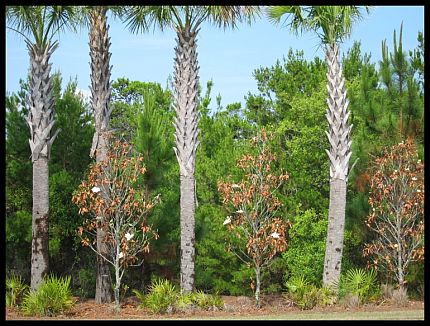It’s (apparently) Dead Tree week here on the GP!
[To my GP colleagues…we should make “Right Plant, Wrong Place” one of our categories, sort of like “Knock it Off.” Or maybe just “Dead Plants in Action.”]
Exhibit A:

Some unhappy little Magnolias. Drip irrigation was running, which leads me to believe salt spray is the culprit.
I was pedaling my sweet Electra beach cruiser down the sidewalk on Cape San Blas, Florida (or Cape San Blarrrgh, if you caught my post last week) and happened upon this tragedy. In the background is natural coastal sand pine scrub including saw palmetto and myrtle oak. Growing on nothing but sand and a bit of decaying organic matter, 300 yards from the ocean, these are tough plants. Pretty darn salt tolerant. Cabbage palms, also very salt tolerant, marched along the sidewalk. Southern magnolias had been planted in between, and they weren’t faring as well.
Just like “deer resistant,” “salt tolerant” is a rather vaguely-defined grouping of plants. You can find list after list on the interwebs and in the back of nursery catalogs and reference books. The source of the information is rarely confirmed, and if so, it’s the same Extension publication that has been cut and pasted to death. Degrees of salt tolerance are further described as “high,” “moderate” and sometimes “low” without any quantitative parameters (a range of soil electrical conductivity perhaps?). There are tremendous scientific resources (including funding) devoted to breeding for salt tolerance of food crops like rice, barley, and soybeans. Ornamental plants are pretty unimportant in the grand scheme of things (like the global food supply) thus the mere smattering of practically unfunded research out there, leaving us with only anecdotal evidence. Though some lists have M. grandiflora listed a “moderately” salt tolerant, I vote to move it to “low.”
*crickets*
Wish we could grow Southern Magnolia…..but the cold gets it way before the road salt.
Maybe the Magnolias should be moved to “not” salt tolerant??
The breeding for salt tolerance will be incredible achievement which inevitably will increase the adaptability of the plants planted in regions with such specifil atmospehere peculiarities.